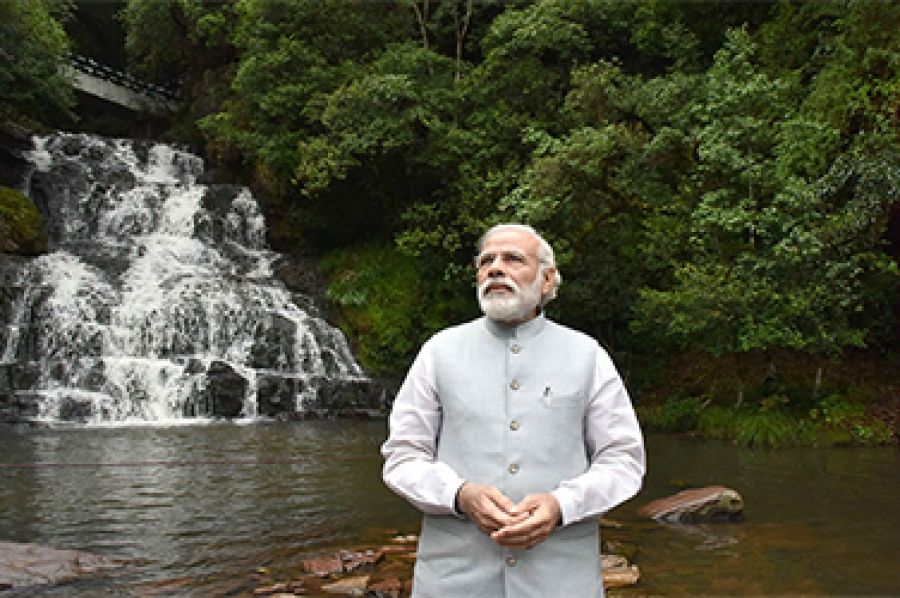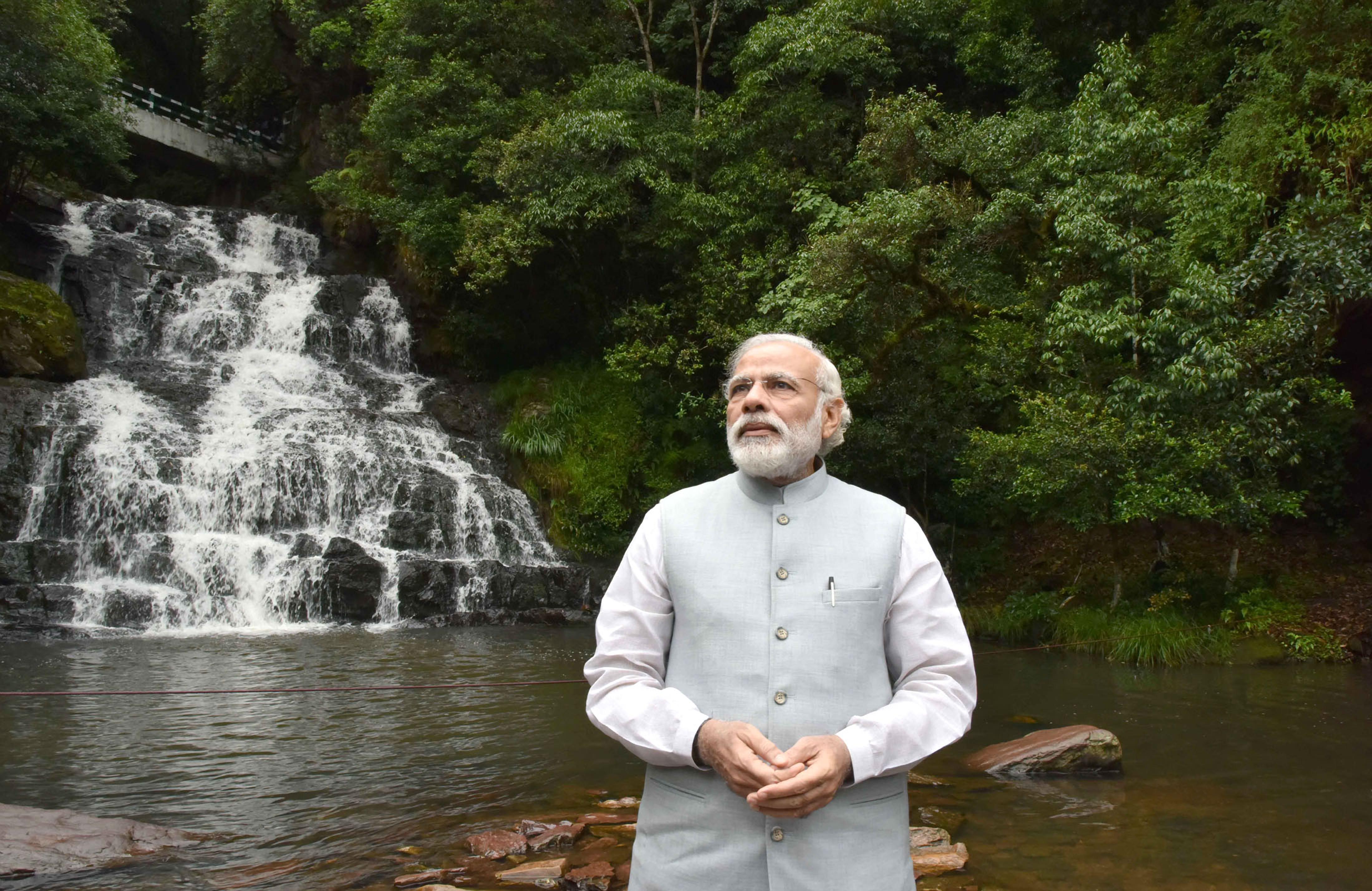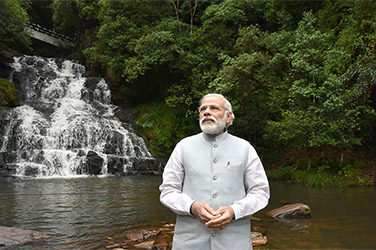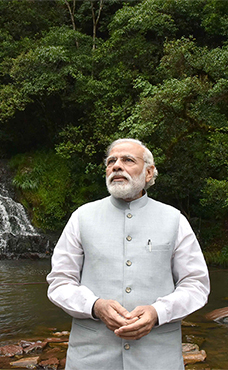
- Free Article: No
- Contents Category: Commentary
- Custom Article Title: The power paradox: Illiberalism and Hindu majoritarianism in Modi’s India
- Review Article: Yes
- Article Title: The power paradox
- Article Subtitle: Illiberalism and Hindu majoritarianism in Modi’s India
- Online Only: No
- Custom Highlight Text:
On 15 August 2022, it will be seventy-five years since Jawaharlal Nehru declared that India’s ‘tryst with destiny’ had finally been ‘redeemed’. The rapturous crowds that gathered outside the Constituent Assembly in New Delhi on that sultry summer night cheered as loudspeakers relayed the words: ‘At the stroke of the midnight hour, when the world sleeps, India will awake to life and freedom.’
- Article Hero Image (920px wide):

- Article Hero Image Caption: Indian Prime Minister Narendra Modi tours Elephant Falls in Shillong, Meghalaya, India (photograph via PIB/Alamy)
- Alt Tag (Article Hero Image): Indian Prime Minister Narendra Modi tours Elephant Falls in Shillong, Meghalaya, India (photograph via PIB/Alamy)
- Featured Image (400px * 250px):

- Alt Tag (Featured Image): 'The power paradox: Illiberalism and Hindu majoritarianism in Modi’s India' by John Zubrzycki
As president of the Congress Party and India’s first prime minister (1947–64), Nehru was acutely aware that the price of his country’s hard-won independence was the partitioning of the subcontinent along religious lines. There would be no question that India would follow Pakistan’s example. Secularism became the mantra of the newborn nation. Writing in his magnum opus The Discovery of India (1946), Nehru insisted that it was ‘entirely misleading to refer to Indian culture as Hindu culture’. For him, India was ‘a cultural unity amidst diversity, a bundle of contradictions held together by strong but invisible threads’.
Guaranteeing the rights of minorities both religious and ethnic became a central tenet of India’s Constitution when it came into effect on 26 January 1950. Discrimination based on caste and creed was made illegal. On the economic front, the rallying cry became self-reliance. Gandhian protesters had once burned British cloth to break the yoke of foreign economic domination. The new India would make its own steel, manufacture its own cars and clothing. Inspired by the Soviet model, it embraced five-year plans, introduced the ‘licence Raj’ to regulate the economy, and built massive dams that were dubbed ‘temples of modernity’.
The smashing electoral victories of the Bharatiya Janata Party in the 2014 and 2019 elections have irrevocably changed India’s political, social, and cultural landscape. Not only did the BJP become the first party to win an outright majority in the Lok Sabha (or Lower House of Parliament) in more than two decades, it left Congress so decimated that it no longer qualifies as an official opposition. Prime Minister Narendra Modi is arguably the world’s most powerful politician based on the size of his electoral mandate, the reach of his party’s machinery, and his presidential ruling style. Impervious to criticism, he has never held a press conference and has much of the mainstream media in his thrall. The seemingly unassailable entrenchment of the BJP has raised fears of ‘democratic dictatorship’ or a version of ‘bureaucratic authoritarianism’ taking hold of India’s political landscape.
For the first time since 1947, the BJP has succeeded in harnessing the Hindu vote nationally, in the process sweeping aside caste and language-based parties as well as those whose ideologies are based on secularism and economic nationalism, such as the communists. The days when Nehru’s successor, Lal Bahadur Shastri (1964–66), castigated a journalist for daring to ask what religion he belonged to are long gone. Today even Congress leader Rahul Gandhi, scion of the Nehru–Gandhi dynasty, deems it necessary to be seen in public wearing the sacred thread that denotes his Brahmanical caste and to make offerings at Hindu temples.
Since coming to power in 2014, Modi has promoted the politics of Hindutva or Hindu nationalism, a millenarian project that involves everything from rewriting citizenship laws that disadvantage Muslims to the striking down in 2019 of the special constitutional status of India’s only Muslim majority state, Jammu & Kashmir. Streets and cities have been renamed to reflect India’s ‘Hindu identity’, school curricula have been moulded to reflect India’s glorious Vedic past. In the southern state of Karnataka, Muslim girls are forbidden to wear the hijab in schools, and the study of the ancient Sanskrit text the Bhagavad Gita is now mandatory. Irrefutable archaeological and linguistic evidence is being discarded in an attempt to prove that the Aryans who brought the Sanskrit language and the roots of Hinduism from Central Asia not only predated all the other civilisations of the subcontinent but also originated there.
To make Hinduism the basis of a nationalist project seems paradoxical. As a faith it has no single church, no recognised authority or single text that defines its beliefs. Its multiple deities are worshipped mainly in domestic shrines or wayside temples. Paradoxical, too, is the claim of victimhood in a country where Hindus make up more than eighty per cent of the population and dominate government, business, and the bureaucracy. But the alleged appeasement of religious minorities under previous secular regimes, coupled with the argument that centuries of Islamic oppression must be avenged, are potent messages easily spread on social media where viral videos showing Muslims being attacked because of their religion are becoming an almost daily phenomenon.
In recent years, India has witnessed an upsurge of campaigns targeting the consumption of beef and the slaughter of cows – an animal sacred to Hindus. Opposition to ‘Love Jihad’, the claim that any marriage between a Muslim man and a Hindu woman is a form of forced conversion, has led to legal prohibitions on intermarriage being introduced in states such as Uttar Pradesh, where the ghar wapsi or homecoming movement that seeks to reconvert Christians and Muslims to the Hindu fold is growing.
The electorate’s acceptance of a shift towards Hindu majoritarianism is not an aberration. A 2017 Pew Research Center report found support for autocratic rule higher in India than in any other nation surveyed. A majority (fifty-five per cent) of Indians backed a governing system in which a strong leader can make decisions without interference from parliament or the courts, while fifty-three per cent supported military rule. In today’s India, China is increasingly being seen as the model for countries wanting to lift themselves out of poverty and to become economic powerhouses thanks to the strong hand of their rulers.
A more recent Pew Research Center poll found that religious divisions are deeply entrenched. The 2021 survey found that while eighty-four per cent said that to be ‘truly Indian’ it is very important to respect all religions, this commitment to tolerance is accompanied by a strong preference for keeping religious communities segregated. Most Indians admitted they have little in common with members of other religious groups, with eighty-six per cent of Hindus saying that their close friends come mainly or entirely from their own religious community. The survey also found that that roughly two-thirds of Hindus are opposed to interfaith marriage. The figure for Muslims was even higher, with eighty per cent saying it is very important to stop Muslim women from marrying outside their religion.
Socio-economic factors are powering the BJP juggernaut. India is recording strong economic growth after a Covid-19 inflicted recession, but this has yet to be translated into generating enough jobs to absorb the millions entering the workforce every year. By one estimate, Covid lockdowns saw an additional 230 million individuals fall below the national poverty line. Half of all women working in the formal and informal sectors lost their jobs. According to the Centre for Monitoring Indian Economy, unemployment is rising and stands at nearly eight per cent, the highest rate in more than three decades. School leavers and even university graduates are finding it difficult to get jobs. In late 2021, in the state of Madhya Pradesh, 11,000 people applied for fifteen lowly paid government positions as clerks, drivers, and watchmen.
The CMIE’s estimate of eight per cent unemployment only applies to the formal sector of the economy that employs around one in ten of the working age population. The jobless rate in the informal sector is estimated to be more than forty per cent. It is from this vast pool of disaffected citizenry that the BJP is drawing much of its strength, diverting attention away from broken promises on the economic front to its Hindutva-inspired agenda of victimhood. With a majority of these unemployed coming from the economically backward and more conservative states of the Hindi-speaking heartland, the BJP’s political agenda looks set to remain hostage to reactionary forces. This is reflected in the party’s second consecutive victory in this year’s Assembly elections in India’s largest state Uttar Pradesh, where its saffron-clad chief minister, Yogi Adityanath, a mahant or temple priest, is being spoken of as Modi’s eventual successor as leader of the BJP.
If the communal clashes led by sword-waving Hindu youths targeting Muslim localities and mosques that broke out in New Delhi and several central Indian cities in April are any guide, the BJP may be falling into what political scientist Pratap Bhanu Mehta calls a ‘power paradox’ trap where the forces it unleashed in its quest for political supremacy are becoming increasingly hard to control. ‘These foot soldiers of political violence are not easy to decommission. Now that they have tasted the elixir of political legitimacy, the genie will not go back into the bottle. In that sense, the triumph of reactionary politics should not be measured only by its electoral victories or entrenchment in the state. It should be measured by the fact that wherever it has gone, it is breaking apart whatever modest social capital India had.’
Organisationally, the BJP draws its strength from the Rashtriya Swayamsevak Sangh (RSS), the largest volunteer organisation in the world. Inspired at its founding by European fascist youth organisations of the 1920s, its four million members run everything from flood relief programs to coaching classes for job seekers. It was an RSS member who assassinated Mahatma Gandhi in 1948 because he was considered too tolerant towards Muslims. Modi started off his political career as an RSS cadre.
Despite the BJP’s vast base and the lack of viable political alternatives, there is nothing inevitable about India’s drift towards majoritarianism. As the noted political scientist Sumit Ganguly argues: ‘The sheer cultural, linguistic, and ethnic variety of the country will not be easily steamrolled. India’s inherent diversity will stand in the way of forging a regime that embraces illiberalism. Indeed, it can be argued that India has endured as a working, if chaotic, state precisely because of its commitment (even if flawed and partial) to liberal democracy.’
Indian politicians still recognise that legitimacy comes from the ballot box. They know that unfulfilled promises will come back to haunt them. An assertive and growing middle class, many of whom are paying taxes for the first time, are demanding real accountability from elected officials. The wider electorate is savvy enough to know the importance of changing governments, particularly at the state level. There is an old Hindi saying that you can’t make a chapatti unless you flip it over: cook only one side and it will burn. India’s experiment with democracy may be charred, but it remains its best hope as the country faces an uncertain and challenging future.
This is one of a series of politics columns generously supported by the Judith Neilson Institute for Journalism and Ideas.



Comments powered by CComment